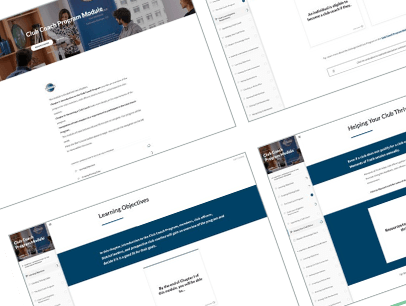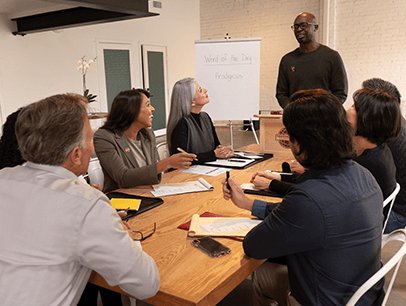
Let’s face it: Some Toastmasters clubs struggle. Whether the problem is a lack of members or a lack of volunteers for officer and meeting roles, certain clubs need help.
And help is available. District leaders can appoint one or two coaches to assist clubs around the world. These experienced Toastmasters are there to help the club rebuild its membership, restore a quality environment, and most importantly, reach a point where it is sustainable for many years to come.
Being a club coach has often been described as the toughest job in Toastmasters. It’s certainly one of the most important—a mission that ultimately can help many people become better communicators and leaders.
“The journey is bigger than you,” says Julie Richardt, DTM, a club coach in the 2020–2021 program year. “Your journey touches and influences others.”
Here are suggestions to help make the coaching experience a success, for both coach and club.
Offer Encouragement
Richardt says being a club coach is time-consuming and a lot of work, but if you stick with it, it’s a fulfilling journey. “I would tell future club coaches not to get discouraged,” she says.
Richardt is a member of several clubs in Charlotte, North Carolina. She and Kayren Cathcart, DTM, teamed up to become co-coaches of the ATD Toastmasters, a corporate club in Huntersville, North Carolina. Cathcart, also a member of several Charlotte clubs, agrees that it’s important to maintain a positive attitude and support members who may be frustrated.
“Club members may perceive setbacks—such as non-renewals, low attendance, or even organizational changes—that affect their participation,” she says.
Bob Harman, a charter member of ATD Toastmasters, says the club started off with a strong membership but suffered during the pandemic.
“I didn’t want to come in as a know-it-all. I wanted to get to know [the officers and the members] as people.”
—Andrej Mazary, DTM“We went to Zoom meetings and some people didn’t want that,” he says.
Cathcart says she and Richardt worked with the ATD members to reframe the club’s online meetings “as opportunities to reach more people beyond their nucleus, instead of seeing [such meetings] as a setback to not meeting in person.”
Harman says the tactic helped. The club adjusted to online meetings, ultimately considering them to be a positive environment.
Having the club coaches was a great asset to the ADT club, says Harman.
“They were cheerleaders. But they also helped us with ideas to increase participation. We talked about holding an open house, doing a club newsletter, and inviting friends as guests.”
Help Club Officers
Andrej Mazary, DTM, is a member of Slovenski Toastmasters in Bratislava, Slovakia. He became a coach in September 2020 for the Toastmasters Nitra club in Nitra, Slovakia, and found that the officers were suffering burnout.
“I had been a mentor of the club eight years ago after it chartered, so I have an interest in seeing the club thrive,” says Mazary. “The Division Director asked me to help.”
Mazary says that it’s important for a coach to understand what the club members need and want. “I didn’t want to come in as a know-it-all. I wanted to get to know [the officers and the members] as people.”
Daniela Obertova, Club President during Mazary’s coaching assignment, says his efforts paid off dramatically for the club, helping improve relationships among officers and leading to an atmosphere that is “more relaxed, friendly, and open-minded. Chaos was replaced by harmony. Also, the quality of the meetings went up due to better planning and starting to use EasySpeak more effectively.”
Richardt and Cathcart met with the ATD club officers and members several times so that everyone could get to know each other. “We also met with the officers weekly to offer suggestions and encouragement,” says Richardt.
Keeping the communication flowing is crucial as well. Cathcart says she had to learn how to communicate with members who were more analytical and methodical than she. “I am a laid-back creative type. I had to adapt my communication style to the club members,” she says. “What seemed like resistance was often evidence that they needed more time to process what was being presented.”
Revitalize Meetings and Pathways Participation
Many low-member clubs may meet regularly but not have complete meetings. Having a full meeting with at least one prepared speech, Table Topics®, and an evaluation session is a key element to getting a club back on track.
Full, engaging meetings make it easier to meet educational goals in the Distinguished Club Program (DCP). The DCP recognizes club achievements that provide a high-quality experience for members. That’s why one of a coach’s goals is to help the club achieve Distinguished or higher status in the program.
“We encouraged members to complete a level in Pathways,” says Richardt. “We also strongly supported the idea of having a full agenda for a meeting.”
Guests and members are more likely to see the full impact of Toastmasters when a full agenda is available at every meeting. “We wanted the members to see Toastmasters as bigger than their home club,” says Cathcart. “Getting them to visit other clubs, participate in speech contests, was something that I viewed as important.”
Mazary agrees with an emphasis on meeting goals for the DCP. But he says the program results will come naturally when the individuals are happy and enjoying themselves. “The people are the club, there is no club without people,” he notes. “When you’re going to have joyful and fulfilled members, you will have the DCP.”
Obertova, the former Club President, agrees with Mazary’s approach.
“The biggest game-changer that Andrej taught me was to realize Toastmasters is about having fun and trying new ideas, and that it is okay not to be perfect,” she says.
More Ideas
Other suggestions from Richardt, Cathcart, and Mazary include finding new ways to advertise the club, talking with other club coaches for ideas, and not being afraid to ask, “How can we change this?” Since ATD is a corporate club, Richardt and Cathcart stressed to the members how important it was to get support for the club from the organization’s management.
The three coaches’ clubs achieved Distinguished status in 2020–2021: Select Distinguished for ATD Toastmasters and President’s Distinguished for Toastmasters Nitra. The coaches were thrilled and each says they learned something significant during their journey.
“I learned that I need to approach a club in a positive way,” says Mazary. “I need to believe that they can achieve success no matter how discouraged they may be in the beginning.”
“The biggest game-changer that Andrej taught me was to realize Toastmasters is about having fun and trying new ideas, and that it is okay not to be perfect.”
—Daniela Obertova“We are all learning to be effective leaders and helping others in their Toastmasters walk,” adds Richardt.
You also help yourself. Being a club coach is challenging but you learn so much from it, says Cathcart.
“I remember that I was pulling my hair out because we were so close to meeting our goal and needed just one more big push,” she says. “Then I realized that the process was more important than the outcome.
“I grew in my leadership and communication skills more than I expected. My confidence also grew. The club coach experience was a blessing.”
Peggy Beach, DTM is a freelance writer and communications instructor in Raleigh, North Carolina. She is a Past District 37 Governor. A member of the Hi Rise Toastmasters in Raleigh and the Top Triangle Toastmasters in Morrisville, she is available at writereditorpeggybeach@gmail.com.
Related Articles

Toastmasters News
Boosting the Club Coach Program

Club Experience
Distinguish Yourself and Your Club

Club Officers



 Previous
Previous

 Resources to Help
Resources to Help
 Previous Article
Previous Article